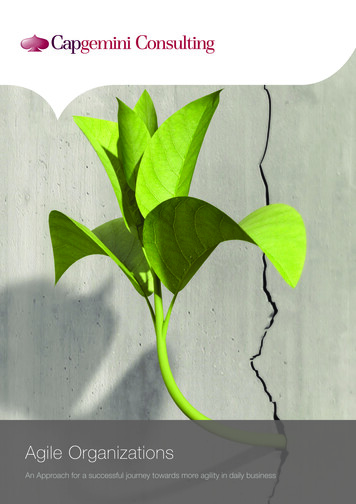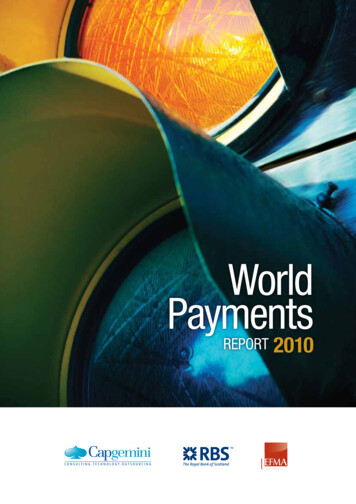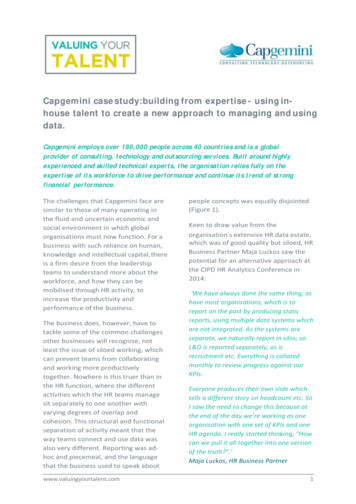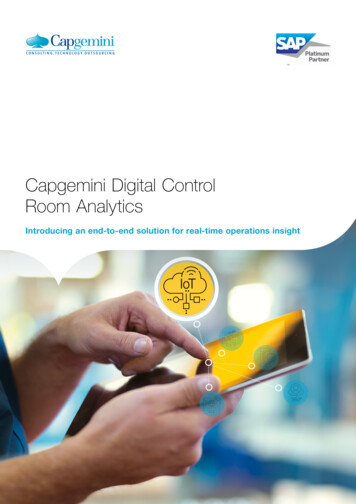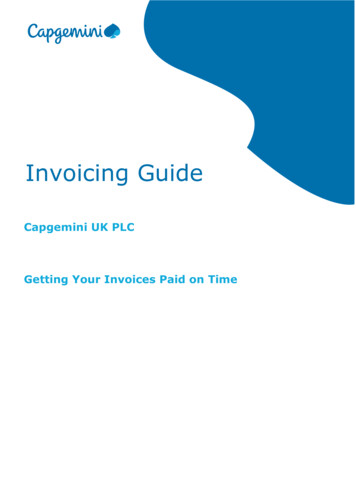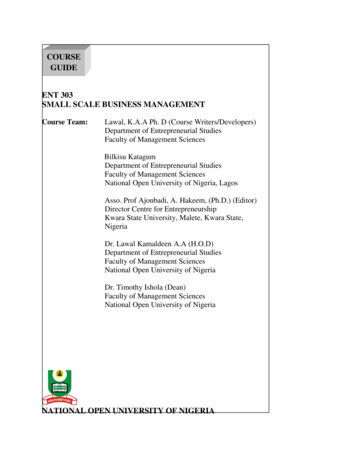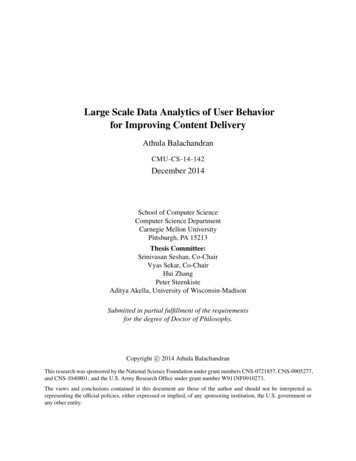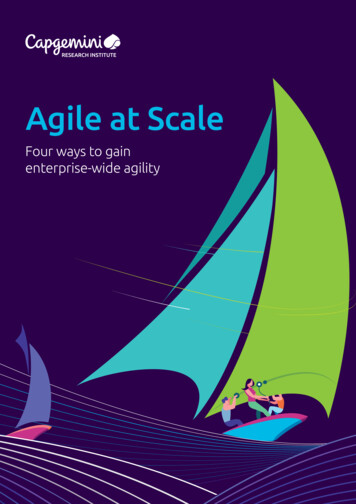
Transcription
Agile at ScaleFour ways to gainenterprise-wide agility
2Agile at scale – Four ways to gain enterprise-wide agility
Introduction“Among the many aspects of Agile are the ability to move morerapidly, adapt to market conditions faster, and gain value inincremental components.”Jeff Farney – vice president, Information Technology,SouthWest Water CompanySAAB’s Gripen fighter jet was developed in carefullycoordinated, three-week iterations at just 18% of the cost ofthe F-35 jet. Using these Agile-inspired techniques has helpedmake it the world’s most cost-effective military aircraft.1During show production, Netflix relies on the Agile principlesof fast feedback and iterative changes via deep data analytics.As a result, Netflix Originals have a 35% higher success ratethan other TV shows.2 These are just some of the benefitsthat organizations are reaping by scaling Agile techniques (aniterative, incremental approach to manage change) to helpdeliver greater organizational agility.approach, and do not focus on continuous learning– drawingon what they have learned that is new – they will not achieveorganizational agility.To understand what works when scaling agile, we conductedin-depth interviews with more than 45 executives from globalorganizations that have scaled agile beyond IT or at a programor portfolio level. We call these ambitious organizations the“Agile frontrunners”. These organizations are drawn fromvarious sectors, including automotive, aviation, banking,insurance, consumer products, retail, pharmaceuticals,telecom, utilities, and the public sector. Together, theyrepresent combined revenues of over 1.5 trillion. Theexecutives themselves represent a range of functions,such as product development, customer experience, IT,operations, general management, procurement, HR, and salesand marketing.And organizational agility is not only about gaining acompetitive edge – it can also be about sheer survival.Today, the lifespan of an S&P 500 constituent company hasdeclined to just 18 years, down from 60 years in 1958.3 Inthis unforgiving environment, staying relevant is about howfast you can pivot and respond to significant changes, fromcustomer behavior to emerging technologies. Organizationalagility – and the agile techniques that support it – are criticalto drive innovation, sustained growth and long-term value in adisrupted age.The characteristics and approaches of these "AgileFrontrunners" offer four key learning points for scaling agile:However, despite the importance of agility today, manyorganizations struggle to reap the full benefits of the Agileapproach. Many are overwhelmed by the considerabletransformation effort involved in scaling Agile from itsorigins as a tactic used in the software field to a programand portfolio level. As a result, they tend to lose focus andmomentum, lapsing back into traditional project-managementmodes. This is because they focus on “doing” Agile without“being” Agile. In other words, they implement Agile practicesbut do not change mindsets, adopt methodologies withoutvalues, and apply frameworks without principles. Moreover,if organizations do not continuously evolve their agileIn this report, we start by defining our different terms, suchas Agile and business agility, before examining why onlya handful of organizations are able to reap the significantbenefits on offer from scaling Agile. We then examine the fourcritical success factors for turning this situation around andseizing the scaled agile prize. Experiment: Start with customer-focused initiatives;scale gradually Orient: Change culture by changing behaviors and focus ondeveloping T-shaped skills Govern: Link Agile portfolio planning and operations withbusiness strategy Accelerate: Modernize IT with DevOpsi and microservices3
Defining Agile, Agile at scale andBusiness agilityThe concept of agile originates from Toyota’s approach to lean manufacturing from the 1940s – which promoted continuousimprovement and elimination of waste. In the 1990s, these principles were adapted by the software industry in the form ofiterative development of software, with Agile going on to focus on areas such as incremental software development, deliveringcustomer value and human elements, such as team autonomy and self-organization. With the adoption of Cloud and DevOps,Agile methods were mixed with iterative development. In recent years, Agile has crossed over from the IT domain to non-techparts of the business, supporting the broader remit of organization-wide agility, with a focus on culture and mindset to achievebusiness objectives.There are a number of critical distinctions in the terminology used:AgileAgile refers to the mindset and behaviors that support an iterative, incremental approach to manage changes in design, build,deployment and adoption of products in a highly flexible and interactive manner. Typically, it involves self-governing, crossfunctional teams working on the product. In this case, “product” might be any kind of deliverable from an Agile team, such assoftware, a customer product, a process improvement, or a marketing campaign, etc.Agile at scaleThe simplest form of Agile product development is at team-level – which is the foundation. However, in order to create aholistic Agile organization, the practices, values, principles and mindsets of Lean-Agile must be applied beyond teams – toprograms, portfolios, and beyond IT as well.Scaling agility has two dimensions – horizontal and vertical. In our report we look at these dimensions at portfolio andenterprise levels.4Agile at scale – Four ways to gain enterprise-wide agility
1. At a portfolio levelScaling at a program level allows several independent agile teams to jointly plan, develop, integrate, test and deploy a productbased on an integrated product vision. The portfolio level scaling also enables several parallel programs to work on differentproducts, including a comprehensive Lean-Agile portfolio management, and at the same time oriented towards a commonstrategic vision (see Figure 1).Figure 1. Scaling Agile from team to program to portfolioPortfolioScaling levelPortfolio VisionProgramIntegratedProduct VisionTeamProduct VisionSource: Capgemini, “Agile organization: From buzzword to reality,” July 2017.Scaling at a program and portfolio level is a complicated exercise, as it questions many basic organizational assumptions anddemands a cultural-shift. There are several frameworks in the market for supporting this change process, including Scaled AgileFramework (SAFe), Large-Scale Scrum (LeSS), Nexus, and Disciplined Agile (DA) among others.2. At the enterprise levelScaling agile at an enterprise level means adopting a Lean-Agile mindset and Agile concepts at a functional level – such as HR,sales, finance or procurement – with different groups also collaborating. Strong senior leadership, clear governance, and arobust infrastructure are all required to make it work.Business agilityBusiness agility is the ability of an organization to rapidly adapt to market and environmental changes in a productive andcost-efficient way. Although agility can exist in individual teams by applying Agile principles, business agility is achieved when acompany is operating in an Agile manner at scale. Put simply, scaling Agile is an enabler of business agility.Among the many aspects of Agile are the ability to move more rapidly, adaptto market conditions faster, and gain value in incremental components.Jeff Farney – vice president, Information Technology, SouthWest Water Company5
Scaling Agile can drive significantrewards, yet only a handful oforganizations are successful at itScaling Agile leads tosignificant value upsideOrganizations today are in the epicenter of a perfect digitalstorm. In today’s everchanging environment, as customerexpectations rise, regulations intensify, new rivals emerge,technologies advance and borders between industries blur– it is critical for organizations to adapt to the speed of thischange. In this disrupted world, organization-wide agilityis crucial to accelerate time to market, improve customercentricity, gain competitive edge and to stay relevant.We asked the executives, in our survey, all of whom have spentover three years in scaling Agile, about where Agile deliversthe greatest value. As Figure 2 shows, they pointed to focusingthe organization on what is strategically important, followedby delivering customer value.Figure 2. Top five sources of business value from Agile transformations1. Focus on what is important for business2. Deliver better customer value3. Faster value delivery/quicker releases4. Better employee morale5. Streamlined workSource: Capgemini Research Institute, Agile at scale in-depth interviews, July–August 2019, N 46 Agile frontrunner organizations.Furthermore, a key benefit of Agile is faster delivery of value.Scaling Agile at Africa’s largest bank – Standard Bank – realizedsignificant gains: team productivity increased by 50%, andtime to market reduced from 700 days to 30 days.4Agile also aligns work across the organization, establishesclear priorities based on a shared vision across teams.Moreover, extending Agile to the wider organization changesthe perspectives of employees and empowers them to delivervalue to internal or external customers. It helps employeesat all levels understand the big picture and how they cancontribute to organizational objectives.6Agile at scale – Four ways to gain enterprise-wide agilityMany organizations havebegun the Agile journey, butfully scaled adoption is rareA recent survey of global software development executivesfound that more than 90% of organizations practice Agile tosome degree, but fewer than 20% have achieved a high levelof competency with Agile practices across the organization.5Even organizations that have realized some success byadopting Agile methodologies face significant challenges withscaling Agile. Our study focused on a specific sample of “AgileFrontrunners” – those who have either scaled Agile beyondIT/digital centers of excellence or at a program/portfoliolevel. Yet, even with these accomplished organizations, there
are still significant challenges in realizing enterprise-wideagility. As Figure 3 shows, 82% cited culture and mindsetchange as significant obstacles in achieving agility. As asenior executive at a global investment bank told us, “Thecore of scaling Agile and DevOps is culture change. Shifting aculture is an entirely herculean tasks, because every culture – thepeople, the processes, and the place – exists for a reason. And,shifting the culture isn't instantaneous.” Notwithstanding thesoft aspects such as culture, technical aspects also hamperagility. We found that close to two-thirds (64%) said that thetechnical dimension is moving too slowly. Over half (53%)Figure 3. Key challenges faced by Agile Frontrunners in scaling AgileCulture and mindset are the biggestobstacles in scaling Agile82%The technical side of the transformation is notprogressing at the desired pace, limiting autonomy,flexibility and productivity gains of delivery teams64%Business objectives are not fully alignedwith the intent of transformation56%Senior leadership still expects traditional waysof reporting and risk managementEarly productivity gains are not being sustainedor replicated throughout the organisation53%36%Source: Capgemini Research Institute, Agile at scale in-depth interviews, July–August 2019, N 46 Agile frontrunner organizations.also said that senior business leaders are often still weddedto traditional approaches. The frontrunners pointed to thechallenge of ingraining an understanding of, and adoption of, aculture of “fail fast” among leaders. Often, the Agile values oftransparency and trust are at odds with traditional commandand-control styles of project management. Organizationsneed to address these mindset issues well before they beginto scale Agile. “Leadership has to live the Agile way,” says anexecutive at a German industrial manufacturing company. Existing organizational operating model often conflicts withthe Agile organizing principles Leadership adopting Agile practices and methodologieswithout clarifying expected behaviors at all levels. This cangive rise to several myths around Agile (see insert below fordetails) across the organization.During our research, organizations pointed to several otherexecution challenges: Teams tend to adapt Agile processes into their old ways ofworking, entirely defeating the purpose of Agile. A leadingglobal bank executive told us, “People want their minimumviable product (MVP) to be such a huge product that they forgetthe concept of what MVP means.” Product owners become prescriptive – prioritizing productfeatures based on their internal view of needs instead oftesting each hypothesis with real customers. Teams readily implement ceremonies (such as daily stand-upmeeting) and adopt tools but not the underlying principles.Once the trainer/coach leaves and the team is on its ownto deliver, it tends to forget the principles, driving in theopposite direction of sustaining agile ways of working.7
Common myths associated with AgileThe misconceptions about agile exist at all levels in an organization. We have highlighted below some of thecommon myths about Agile:Figure 4. Common myths associated with AgileCommon myths associated with agileMythsabout AgileAt a leadership levelAt a mid-managementlevelMyth 1:Agile is a silver bullet:Myth 1:Agile means no architectureDirector at a large MNC pharmagiant says, “Agile helps people focusmore and allows organizations tomake changes to the changing marketdynamics faster. But there are a lot ofother factors that need to cometogether in order to contribute to thatsuccess. And Agile is just one wayof operation.”As per the Agile Manifesto –the best architectures,requirements and designsemerge from self-organizingteams. However, it does notmean no design or noarchitecture. You do not needa big up-fro
There are several frameworks in the market for supporting this change process, including Scaled Agile Framework (SAFe), Large-Scale Scrum (LeSS), Nexus, and Disciplined Agile (DA) among others. Team Program Portfolio Scaling level Product Vision Integrated Product Vision Portfolio Vision 5. Scaling Agile can drive significant rewards, yet only a handful of organizations are successful at it .
